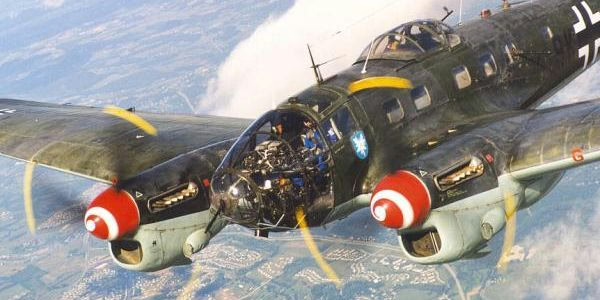Heinkel He 111 History
The Heinkel He 111 was designed by Siegfried and Walter Günter for dual rôles, as a high-speed transport and as a bomber for the still-secret Luftwaffe. In one form or another, the He 111’s service career extended more than thirty years, an outstanding tribute to the design, evolved by the Günter brothers.
Design work began early in 1934, the machine owing much to the single-engined Heinkel He 70 which had captured several international records. The Heinkel He 111 was considerably larger than the He 70, but retained much of that aircraft’s beauty of line. Of the original four prototypes, the first was flown on 24 February 1935, and the second and fourth were completed ostensibly as civilian transports. Bomber production was heralded in the summer of 1935 by the He 111V4 and a pre-series batch of He 111A-0s, but their BMW engines provided insufficient power, and the first major type was the He 111B, with DB 600-series engines.
Anxious to test the aircraft under operational conditions, the Luftwaffe sent a batch of thirty Heinkel He 111B-1s to Kampfgruppe 88 in Spain in February 1937. Forming the bomber component of the Condor Legion, K/88 undertook its first operational sortie on 9 March when it bombed the Republican airfields at Alcala and Madrid-Barajas.
On 10 May, 1940, German forces invaded France and the Low Countries. Operations against the Netherlands began with an attack by the He 111s from KG 4 on Amsterdam and Rotterdam Airports and Ypenburg airfield. Following the Dutch refusal to surrender Rotterdam on 14 May, one hundred Heinkel He 111Ps from Kg 54, under Oberst Lackner, took-off from Delmenhost, Hoya-Wester and Quakenbrück to bomb the city. German sources have subsequently stated that an attempt was made to recall the aircraft, but 97 tons of bombs were in fact dropped on Rotterdam.
Before the beginning of the Battle of Britain the Heinkel He 111H had almost entirely replaced the He 111P series (although most staff crews still flew the older aircraft, and it was in a He 111P that Oberst Alois Stoeckl, commanding KG 55, was shot down and killed near Middle Wallop on 14 August 1940). From the outset the He 111H, with its 435 km/h (270 mph) top speed, proved a difficult aircraft to shoot down (compared with the Dornier Do 17), and showed itself capable of weathering heavy battle damage.
By the time the Stalingrad campaign ended on 2 February, 1943, the units of Lufttransportführer 1 (joined on 1 January by III./KG 55) had lost no less than one hundred and sixty-five Heinkel He 111s, more than half the aircraft committed. The Kampfgeschwader were never to recover from this blow.
Total Heinkel He 111 production was about 7,000. Licence-built He 111H-16s, designated C.2111, were built in Spain by CASA, and served with the Spanish Air Force until well into the 1960s.
Heinkel He 111 Specifications
| Aircraft Type: |
| bomber airplane |
| Dimensions: |
| wingspan: 74 ft, 1 in |
| length: 53 ft, 9 in |
| height: 13 ft, 1 in |
| Weights: |
| empty: 19,136 lb |
| gross: 30,865 lb |
| Power plant: |
| 2 × 1,350 hp Junkers Jumo liquid-cooled in-line engines |
| Performance: |
| maximum speed: 227 mph |
| ceiling: 21,980 ft |
| maximum range: 1,212 mi |
| Armament: |
| 4 × 7.92 mm calibre machine guns |
| 1 × 20 mm calibre cannon |
| up to 4,409 lb of bombs |
| Operational Use: |
| 1936–1945 |










